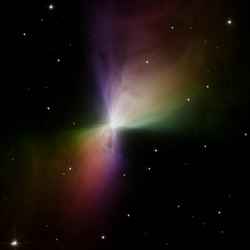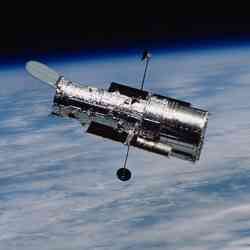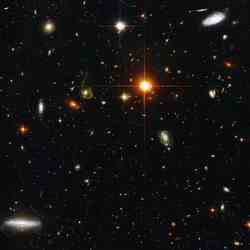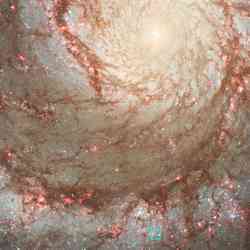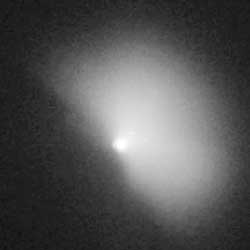Unlike humans, stars are born with all the weight they will ever have. A human’s birth weight varies by just a few pounds, but a star’s weight ranges from less than a tenth to more than 100 times the mass of our Sun. Although astronomers know that stars come in a variety of masses, they are still stumped when it comes to figuring out if stars have a weight limit at birth.
Now astronomers have taken an important step toward establishing a weight limit for stars. Using NASA’s Hubble Space Telescope, astronomers made the first direct measurement within our Milky Way Galaxy that stars have a limit to how large they can form. Studying the densest known cluster of stars in our galaxy, the Arches cluster, astronomers determined that stars are not created any larger than about 150 times the mass of our Sun, or 150 solar masses.
The finding takes astronomers closer to understanding the complex star-formation process and gives the strongest footing yet to the idea that stars have a weight limit. Knowing how large a star can form may offer important clues to how the universe makes stars. Massive stars are the “movers and shakers” of the universe. They manufacture many of the heavier elements in the cosmos, which are the building blocks for new stars and planets. Hefty stars also may be the source of titanic gamma-ray bursts, which flood a galaxy with radiation.
“This is an incredible cluster that contains a rich collection of some of the most massive stars in the galaxy, yet it appears to be ?missing’ stars more massive than 150 times the mass of our Sun,” said astronomer Donald F. Figer of the Space Telescope Science Institute in Baltimore, Md. “Theories predict that the more massive the cluster, the more massive the stars within it. We looked at one of the most massive clusters in our galaxy and found that there is a sharp cutoff to how large a star can form.
“Standard theories predict 20 to 30 stars in the Arches cluster with masses between 130 and 1,000 solar masses. But we found none. If they had formed, we would have seen them. If the prediction was only one or two stars and we saw none, then we could claim that our result could be due to statistical errors.”
Figer is pursuing follow-up studies to determine an upper limit in other star clusters to test his result. His finding is consistent with statistical studies of smaller-mass star clusters in our galaxy and with observations of a massive star cluster known as R136 in our galactic neighbor, the Large Magellanic Cloud. In that cluster, astronomers discovered that stars were not created any larger than 150 solar masses.
Astronomers have been uncertain about how large a star can get before it cannot hold itself together and blows itself apart. Even with the advances in technology, astronomers do not know enough about the details of the star-formation process to determine an upper-mass limit for stars. Consequently, theories have predicted that stars can be anywhere between 100 to 1,000 times more massive than our Sun. Predicting a lower weight limit for stars has been easier. Objects less than one-tenth a solar mass are not hefty enough to sustain nuclear fusion in their cores and shine as stars.
Making this finding was so tricky that Figer spent seven years puzzling over the Hubble data. The results are published in the March 10th issue of the journal Nature.
“Knowing that extraordinary claims demand extraordinary proof, I scratched my head for a long time trying to figure out why the result might be wrong,” he said.
Figer used Hubble’s Near Infrared Camera and Multi-Object Spectrometer to study hundreds of stars ranging from 6 to 130 solar masses. (Although Figer did not find any stars larger than 130 solar masses, he conservatively set the upper limit at 150 solar masses.) The Arches cluster is a youngster, about 2 to 2.5 million years old, and resides 25,000 light-years away in our galaxy’s hub, a hotbed of massive star formation. In this rough-and-tumble region, huge clouds of gas collide to form behemoth stars.
Hubble’s infrared camera is well suited to analyze the Arches because it penetrates the dusty core of our galaxy and produces sharp images, allowing the telescope to see individual stars in a tightly packed cluster. Figer estimated the stars’ masses by measuring the ages of the cluster and the brightness of the individual stars. He also collaborated with Francisco Najarro of the Instituto de Estructura de la Materia in Madrid, who produced detailed models to confirm the masses, chemical abundances, and ages of the cluster’s stars.
A cluster must meet a long list of requirements for astronomers to use it for identifying an upper-mass limit. The cluster must be hefty enough, about 10,000 solar masses, to produce stars large enough to probe the upper limit. A cluster also cannot be too young or too old. Selecting an older cluster ? beyond 2.5 million years ? means that many of the massive young stars have already exploded as supernovas. In a very young cluster ? less than 2 million years old ? many of the stars are still enshrouded in their natal dust clouds, and astronomers cannot see them.
Another important factor is a cluster’s distance from Earth. Astronomers must know the cluster’s distance to reliably estimate the brightness of its stars, a key ingredient used to estimate a star’s mass. The cluster also must be close enough to see individual stars. The Arches cluster is the only cluster in the galaxy that meets all of those requirements, Figer said.
The Arches outshines almost every other star cluster in the galaxy. With a mass equivalent to more than 10,000 stars like our Sun, the monster cluster is 10 times heavier than typical young star clusters, such as the Orion cluster, scattered throughout our Milky Way. If our galactic neighborhood were as cluttered with stars, more than 100,000 stars would fill the void of space between our Sun and its nearest neighbor, the star Alpha Centauri, 4.3 light-years away. Astronomers estimate that only 1 out of every 10 million stars in the galaxy is as bright as the stars in the Arches cluster. At least a dozen of the cluster’s stars weigh about 100 times the mass of our Sun.
Figer cautions that the upper limit does not rule out the existence of stars larger than 150 solar masses. Such hefty stars, if they exist, could have gained weight by merging with another massive star. For example, the young Pistol star, located near our galactic hub, is 150 to 250 times more massive than our Sun. This behemoth star, however, seems out of place because it dwells in a neighborhood of older stars. One way to explain this apparent paradox, Figer said, is that the Pistol could be a “born-again” star, formed from the merger of two stars. His explanation is not just theory. Astronomers have found older stars that have been reborn through mergers with other stars in ancient globular star clusters.
The Pistol also could be part of a double-star system that is masquerading as a single giant star. The two stars have not been unmasked because they cannot be resolved by even the Hubble telescope.
Double-star systems, astronomers also caution, could make up some of the most massive stars in the Arches cluster. This means that the upper limit in the Arches could be lower than 150 solar masses, but not any higher.
Figer’s next step is to pinpoint more clusters to test his weight limit. Several telescopes, including the Spitzer Space Telescope, have been searching for new star clusters in our Milky Way. In the last two years, the number of known clusters in our galaxy has doubled from a few hundred to 500, Figer said. Many of the newly found clusters are compiled in the Two Micron All Sky Survey (2MASS) catalogue. Figer already has identified about 130 of these newly discovered clusters as possible candidates to study. NASA has recognized Figer’s important work by giving him a five-year Long Term Space Astrophysics award, which will support his hunt for the most massive stars in the Milky Way.
Original Source: Hubble News Release
